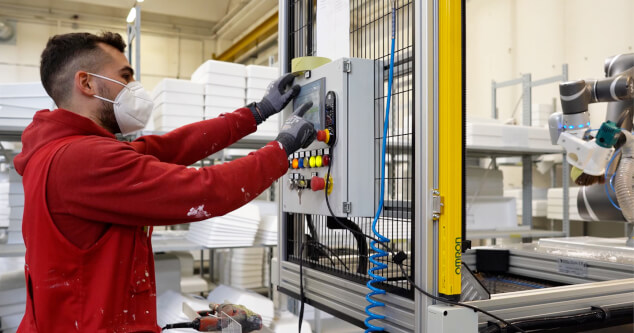Four Automation Tips for SMEs
Publicerat 25 november 2022 i Flexible Manufacturing
Corporate leaders around the world are currently facing one challenge after another: In addition to the exploding costs caused by the energy crisis, there are supply chain problems, a shortage of skilled workers, sustainability requirements, and advancing digitization issues. In particular, small and medium-sized enterprises (SME) need to quickly find ways to address these hurdles. Automation provides a remedy – this includes robotics such as cobots and AMR (autonomous mobile robots), as well as sensors, vision, and AI technology. While companies are well aware of the benefits of such technologies, studies also show that many remain skeptical of their actual use.
Especially companies without application experience fear that the use of robots could be accompanied by high costs. So if you are currently wondering whether the purchase of a collaborative or mobile robot is worthwhile for your own business, OMRON's new ROI calculator will help. It provides a quick overview of the return on investment and shows when a robotics investment will cover its costs.
Automation in medium-sized businesses is picking up speed
There are currently around 23.1 million small and medium-sized enterprises in the European Union. They are an integral part of the economy, although there are differences from country to country. In Germany, for example, 82 percent of the country's value-added comes from SMEs. In the UK in 2021 there were 5.6 million private sector businesses, accounting for 99.9% of the firms, with multiple new entrepreneurs joining the ranks every day. In the EU as a whole, the figure is around 56 percent. The importance of SMEs as employers is also of extreme significance: almost 84 million citizens of the EU work in an SME. The problem: In many places, it is becoming increasingly difficult to find employees. In the EU, around 2.9 percent of vacancies were unfilled in the first quarter of 2022, almost 50 percent more than in the same period last year. As a result, companies are urgently required to find new ways to hire and retain suitable employees.
Technologies that take over manual and repetitive tasks can improve employee safety and work efficiency. Other measures include training initiatives, incentives for new starters, employee programs, and more. Cobots are suitable for SMEs because of their flexibility and their wide range of applications. Studies show that this segment has enormous potential: the market for collaborative robots is expected to grow from $1.2 billion in 2021 to $10.5 billion in 2027. A compound annual growth rate (CAGR) of 43.4 percent is forecast for up to 2027.
Anyone dealing with this topic for the first time is faced with a mountain of questions and considerations. OMRON has compiled four key aspects that should be considered at the beginning of automation projects to drive projects forward, reduce skepticism and get stakeholders on board.

1. Focus on application scenarios and scale up slowly
Companies thinking about automation and cobots should not primarily ask themselves whether they should invest in robotics. It is more important to understand what processes can be made more efficient and how. Very detailed tasks that require experienced manual labor by a specialist can be automated, but come at an immense cost - both in terms of time and resources. To get started with automation, it is advisable to start with small projects and then gradually scale up, adding new workflows, expanding the fleet, and so on. Take the example of a large bakery: Here, company leaders are not primarily asking how a robot can be used, but rather how bread can be transferred from the oven line to the bins destined for the bakery branches, without human intervention.
2. Use robots to support employees
Robots score with flexibility. They can be adjusted and adapted, used in fleets, and more. Depending on the product and area of application, modifications of positions and the addition of extensions are possible so that they can be easily adapted to other or modified tasks. However, this does not mean that they replace employees. Instead, it is a matter of a well-orchestrated interaction between humans and machines. Medium-sized companies should focus on individual tasks at the beginning and not think and plan too complex applications. An expansion of the cobot, for example with a camera to include an image processing system (machine vision technology) is also possible at a later stage, assumed that a robotics partner is chosen that can cover various application areas from a single source and offer a good partner network. The focus must be on: How can robotics help employees? Which manual task can be handed over to a robot so that the human employee can concentrate on more value-adding tasks? Loading and unloading machines as well as palletizing and depalletizing are processes that can be automated relatively quickly and easily. Welding, painting and deburring are other good examples of the use of robots in medium-sized companies.
3. Get employees on board and specialize them
Robots are ideally used to perform repetitive tasks that require constant precision. In the interaction with the robots the human remains the specialist, while the robot manages those repetitive and monotonous tasks. Robotics is not a panacea to solve all problems or a replacement for human workers. This thought should be incorporated into every automation project - also to take away the fear of the employees. Specialists are still needed, for example to assemble products, for process optimization and to perform maintenance tasks. In addition, employees should be aware of the possibilities and be trained to make optimal use of new technologies. While robots take over palletizing, sorting, material loading, or quality control, for example, employees can be more creative and to add value.

To expand the tasks and capabilities of robots, third-party equipment is needed, such as safety devices or image processing and inspection systems. If SMEs in particular can rely on a robotics partner at their side to provide one-stop support, this takes a lot of work and worry off their shoulders: Missing know-how in their own ranks is covered by experienced partners. In an OMRON survey, almost 90 percent of IT managers stated that they depended on external consultants when it came to Industry 4.0 and data analysis. SMEs, therefore, need not only smart technology but also holistic providers and experienced system integrators.
Nine out of ten companies want to introduce robot automation in their respective infrastructures by 2030. Mobile robots and cobots are easy to deploy in this context. This makes these automation products a good option for companies that want to make their production processes more flexible and efficient. OMRON wants to support SMEs in automation and offers leasing options to keep initial investment costs low. The ROI calculator also helps to easily evaluate investments in cobots and mobile robots. This way, companies of all sizes can benefit from the potential of automation and do not have to worry about opaque or hard-to-predict costs.
